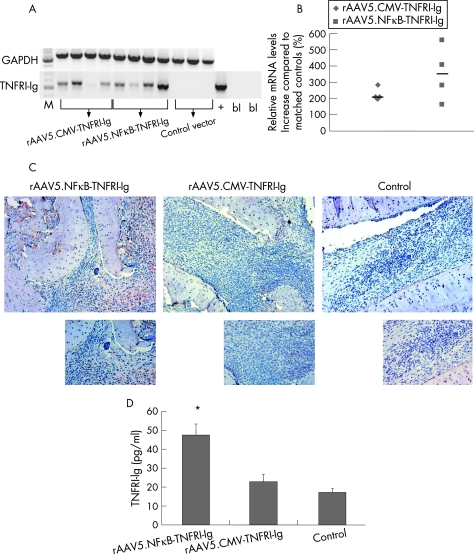Figure 2 Human tumour necrosis factor receptor type I (TNFRI)‐Ig gene transcription in the ankle joints of rats with adjuvant arthritis after local recombinant adeno‐associated virus (rAAV5) gene therapy. Total RNA was extracted from crushed joints 14 days after intra‐articular injection and cDNA was synthesised. Reverse‐transcriptase PCR was performed using primers specific for the human TNFRI‐Ig gene. Plasmid containing the human TNFRI‐Ig gene was used as positive control (+), and a no‐template control as blanks (bl). (A) Rat glyceraldehyde phosphodehydrogenase (GAPDH) was used as a reference gene (n = 4/group). A real‐time PCR was performed to calculate the percentage TNFRI‐Ig upregulation. (B) Obtained threshold cycle (Ct) values were normalised to GAPDH levels and expressed as percentage increase compared with matched controls as individual data points (median). All treated animals significantly overexpressed the transgene in the joints (*p<0.05) (n = 4/group). (C) Ankle joints were embedded in paraffin wax, sectioned and immunohistochemically stained for human TNFRI‐Ig and counterstained with Mayer's haemalum (n = 2/group). Representative pictures are shown (original magnification 100× (upper panels), 200× (lower panels)). (D) Protein was isolated from injected joints and an ELISA for TNFRI was performed. Intra‐articular injection of rAAV5.NFκB‐TNFRI‐Ig resulted in the highest levels of TNFRI‐Ig in joint protein isolates (p<0.05), whereas the cytomegalovirus (CMV)‐driven construct only resulted in TNFRI‐Ig levels slightly above those in controls (n = 4/group).

An official website of the United States government
Here's how you know
Official websites use .gov
A
.gov website belongs to an official
government organization in the United States.
Secure .gov websites use HTTPS
A lock (
) or https:// means you've safely
connected to the .gov website. Share sensitive
information only on official, secure websites.
